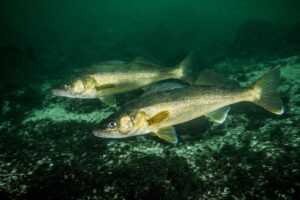Those venturing out early are being rewarded with good walleye action early, things do slow up for the middle of the day before it picks up again for the non-early bird crowd. Many areas are producing fish, the areas around 113 and 125 have been exceptionable. Walleye are still being taken from weed beds in the shallows and those trolling worm harnesses and crankbaits are getting down past 30 FOW as many are working past the drop along the north shore.
Cooler for Sunday as a weak cold front moves into the region, we are expecting a bit of chop as that system moves in but it will remain dry on Sunday and Monday. Showers, storms, and the hot weather return on Tuesday and the week’s forecast looks a bit unstable.
Some cool news from the DEC, a 139-pound sturgeon was caught on Oneida Lake by a research team from Cornell. The 72.5-inch long beast is believed to be one of the 320 stocked on Oneida Lake from 1999. “This catch is great news for New York’s lake sturgeon recovery program,” said State DEC Commissioner Basil Seggos. “The 139-pound sturgeon is the largest recorded from Oneida Lake since stocking began and it’s an encouraging sign that efforts to recover this ancient fish, listed as a threatened species in New York since 1983, are working.” The sturgeon was tagged and measured before it was released back into the lake. Sturgeon in Oneida Lake are known to grow quicker than other populations in other lake bodies. The fish take advantage of the lake’s high productivity and diverse food sources as well as the lake’s relatively warm waters.
Please remember that New York classifies sturgeon as a threatened species. To help continue the restoration program’s continued success, all anglers who catch sturgeon in Oneida Lake should do the following:
1. Handle the fish with extreme care. If it has ingested the hook, cut the line. Never rip out an internally embedded hook.
2. Measure the length of the fish.
3. Note where you caught the sturgeon.
4. Check for tags. Sturgeon are tracked with small yellow tags, inserted at the dorsal fin’s base (the fin on top of the fish). If your fish has a tag, record the number, please do not remove the tag.
5. Release the fish immediately. Remember, sturgeon are classified as “threatened” and must be returned to the water.
6. Call the Cornell Field Station and report your data. The facility’s number is 315-633-9243.
Angler cooperation can enhance the restoration program, thus helping to create new fishing opportunities on Oneida Lake. Perhaps the past will one day return to our lake when a lucky angler hooks into the power of a 100-pound sturgeon!


Be First to Comment